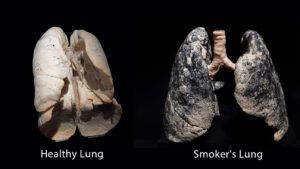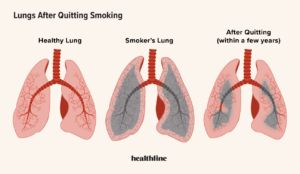Smoking can cause lungs to look blackened, inflated, and inflamed, but some of the damage is reversible. Depending on the extent of the damage, it could take years for your lungs to regain a healthy, pinkish hue.
It’s no secret that smoking can damage your lungs.
Humans experience this lung damage in the form of respiratory diseases, but if you could look inside your chest, the damage would be very visual, too.
The tar in cigarette smoke blackens your lung’s pinkish tissue. It can make your lung larger to compensate for loss of function. Some air sacs in your lungs may burst open, leaving porous holes.
While some of the lung damage from smoking is irreversible, much of it is reversible. Regardless of how long you’ve smoked, quitting can help you improve lung function and help your lungs regain their healthy, pink appearance.


Immediately after you quit smoking, your lungs will show damage from the effects of inhaling cigarette smoke. The extent of the damage will
- the type of tobacco smoked
- your smoking habits, such as how many puffs you take and how much you inhale
- how long you’ve smoked
- specific characteristics of your lungs
But after you’ve stopped smoking for a while, much of that damage will start to heal. The lung is a self-cleaning organ. In cases of acute and limited damage, it can also be self-healing.
Improved lung function will help the lung clean itself more effectively. After a few months, the cilia in your lungs start working efficiently again. Cilia are little hairs that sweep out toxins and foreign particles.
Quitting also improves the function of alveolar macrophages (AMs). These are white blood cells that help protect the air sacs in your lungs (alveoli) where gas exchange occurs.
It’s actually the AMs that trap tar particles in your lungs, causing the black color. When you quit smoking, the AMs can more effectively remove the tar.
But not all damage from smoking is reversible.
For example, lung damage from emphysema is irreversible. That’s when alveoli burst open. Emphysema can cause hyperinflation of the lung and less flexibility in your lung tissue.
A 2020 research review also notes that after extensive damage, lung repair is not regenerative. Healing often results in stiff, scar tissue, and a loss of some lung function.
Some of the effects of quitting smoking happen
Within
While you won’t be able to see the changes occurring in your lungs, you may be able to feel its effects. Within
How long does it take for the tar to get out of your lungs?
Your lungs are self-cleaning. The time it takes to get rid of tar in your lungs will depend on how much tar has accumulated. According to the American Lung Association, if you smoke one pack a day, you’ll filter a full cup of tar through your lungs each year.
Yes, your lungs can heal after 20, 30, or even 40 years of smoking.
Research from 2020 suggests that some cells in your lungs avoid the DNA damage that smoking causes. When you quit smoking, these cells then help replenish the lining of the airways of your lungs. The effect was present regardless of how long the study participants had smoked.
It’s never too late to quit smoking. A 2024 study found that quitting, even at age 65 or older, can improve life expectancy.
Resources for quitting smoking
Quitting smoking can be challenging, but it’s never too late. Resources are available to help you take that next important step. Here are a few:
- Healthline’s “15 Tips for Quitting Smoking”
- Smokefree.gov
- SmokefreeVET (for veterans enrolled in VA healthcare)
quitSTART appTrusted Source
Not all lung damage from smoking is reversible but quitting can help you repair some of the damage. Within a few months of quitting, your lung function will improve, allowing your lungs to clean themselves more efficiently.
Depending on how long you smoked, it could take months to years to filter out some of the black tar that accumulated in your lungs.
Continuing to smoke will further damage your lungs, increasing your risk of numerous health complications. But research has shown that it’s never too late to reverse some of the lung damage.
Talk with a doctor if you need help quitting or need more information.






